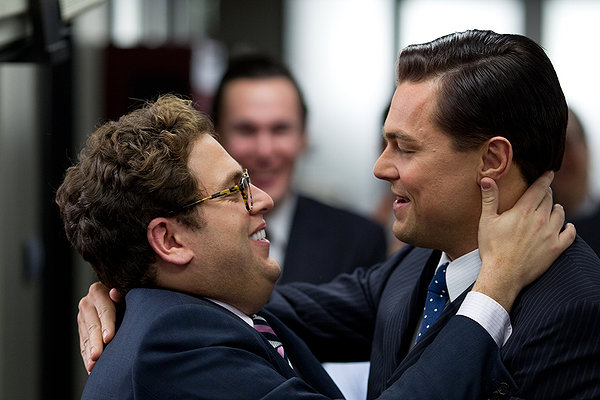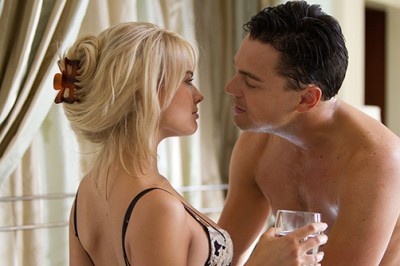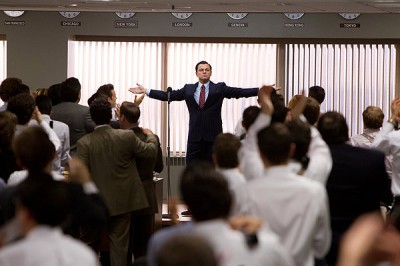
“The Wolf of Wall Street” – a film review by Gary Chew
“The Wolf of Wall Street” is an exciting movie. You’d think it came from the mind of a Hollywood screenwriter, or might be another sequel on Gordon Gekko.
 Not so fast — this Wall Street exposé is based on recent history, and Oliver Stone had nothing to do with these antics of another genuine jerk of the financial world. The script, written by Terrence Winter, comes from the confessional novel of the same name.
Not so fast — this Wall Street exposé is based on recent history, and Oliver Stone had nothing to do with these antics of another genuine jerk of the financial world. The script, written by Terrence Winter, comes from the confessional novel of the same name.
The author’s name is Jordan Belfort (Leonardo DiCaprio). His is a story overboard … in the fast lane. Martin Scorsese keeps his film about Belfort to the “floorboard.” Belfort’s lifestyle and his lack of decency are what make the picture seem pure, if not pulp fiction.
Scorsese hasn’t quite made a pornographic movie, but one of a softer variety; but not too soft. I’d rate it in explicitness along with the HBO-made Liberace bio-pic that starred the actor who played Gordon Gekko in Stone’s 1987 and 2010 movies of Wall Street.
All the stops have been abandoned by Scorsese. “Katie” is not barring any door for any scene, of which there are too many. By my wrist watch, Scorsese’s “Wolf” ran for almost 3 and a half hours. And boy, was I winded.
 Belfort’s “gang” of New York doesn’t actually hang out on Wall Street, but Long Island — in a penny stock boiler room operation bent on swindling money from the not quite so rich. Belfort holds forth as a money-hungry guru, screaming rude motivational epithets to his awe-struck herd of brokers as they start a day’s work on the phone for big bucks.
Belfort’s “gang” of New York doesn’t actually hang out on Wall Street, but Long Island — in a penny stock boiler room operation bent on swindling money from the not quite so rich. Belfort holds forth as a money-hungry guru, screaming rude motivational epithets to his awe-struck herd of brokers as they start a day’s work on the phone for big bucks.
“The Wolf of Wall Street” takes the popular track of two recent films that stretch from serious issues of fact across to high action/extremely comic movies — like the award-winning “Argo” and the current, ballsy caper directed by David O. Russell well-titled as “American Hustle.”
“Wolf” addresses the 1990’s securities fraud and money laundering Belfort foisted on investors, his penchant for Quaaludes, cocaine and bacchanalian revelry and how they affected his personal and family life … including his Lamborghini.
Scorsese maintains his curiosity for Type A, vibrant men who seldom look back at what’s in their wake. Robert De Niro has played Jake, Travis, and Sam for Scorsese. DiCaprio is up to five characters under Scorsese’s directing: Howard, Amsterdam, Billy, Teddy… and now, Jordan. I’d say that the most outrageous Scorsese Two are De Niro’s Travis Bickle and DiCaprio’s present day Jordan Belfort. These are characters, imagined or real, you really want to avoid.
 Backup players bring richness to “Wolf”: Jonah Hill as Jordan’s best man; Rob Reiner as Jordan’s long suffering, decent Dad; Matthew McConaughey stealing his early cameo moments alongside DiCaprio and anyone else in the room; Jean Dujardin (“The Artist”) doing the Swiss banker running a necessarily high class “laundry” business; Kyle Chandler as the effective, no nonsense G-Man … and Australian newcomer, Margot Robbie as the striking Naomi for whom Jordan names his yacht.
Backup players bring richness to “Wolf”: Jonah Hill as Jordan’s best man; Rob Reiner as Jordan’s long suffering, decent Dad; Matthew McConaughey stealing his early cameo moments alongside DiCaprio and anyone else in the room; Jean Dujardin (“The Artist”) doing the Swiss banker running a necessarily high class “laundry” business; Kyle Chandler as the effective, no nonsense G-Man … and Australian newcomer, Margot Robbie as the striking Naomi for whom Jordan names his yacht.
I saw DiCaprio and Scorsese on “Charlie Rose” soon after watching “The Wolf of Wall Street.” Both gentlemen were clear in their disdain for what Belfort stood for in the Nineties. In their conversation with Rose, however, they allowed ample implication to slip forth to entice you to see the film . Yes, swindling, drug use, trysts, female frontal nudity, coarse language and disregard for responsibility do attract the average moviegoer. Such an escape during the dark of winter.
In the vernacular of Comedy Central’s Steven Colbert, “The Wolf of Wall Street” could be thrown into a reversal of message for those who appreciate the true genius of Colbert’s cable television wit. One could conceive Scorsese’s new movie as a morality play, but with a sour ending … as Rush Limbaugh does I’m sure. Imagining that caused me to laugh too.
- Movie Review: ‘The Glorias’ - September 28, 2020
- Movie Review: ‘I’m Thinking of Ending Things’ - September 10, 2020
- Movie Review: ‘The Burnt Orange Heresy’ - August 31, 2020

